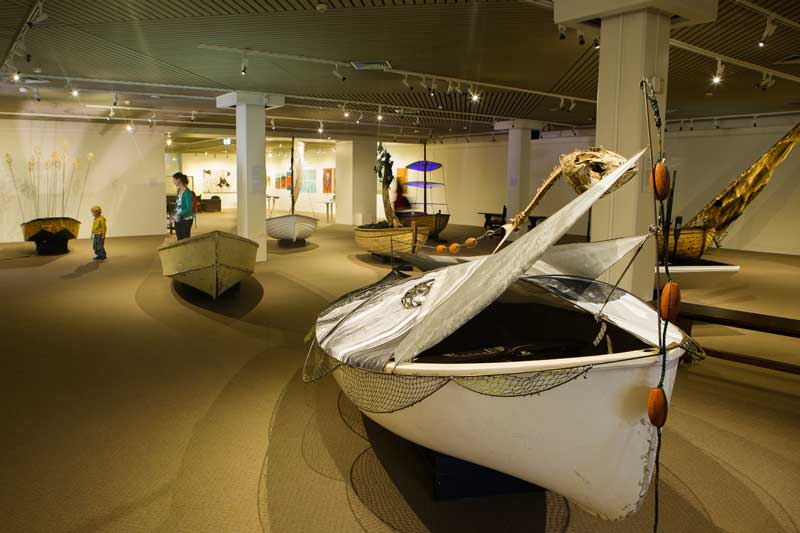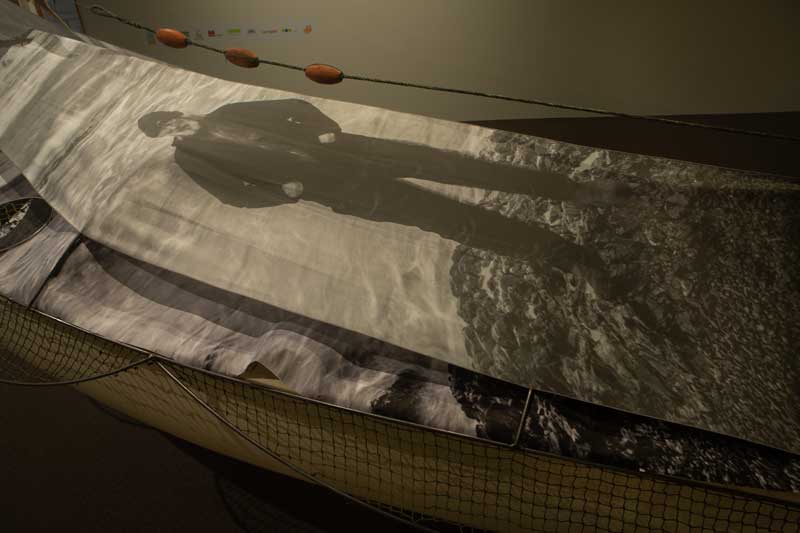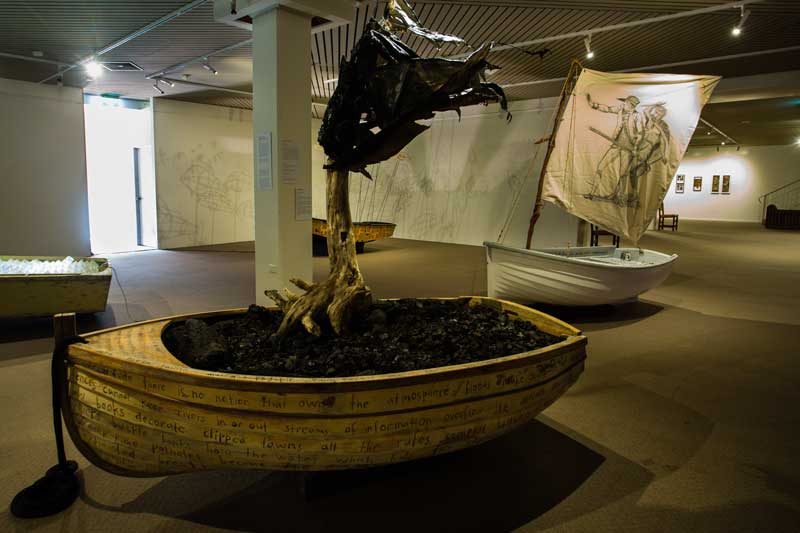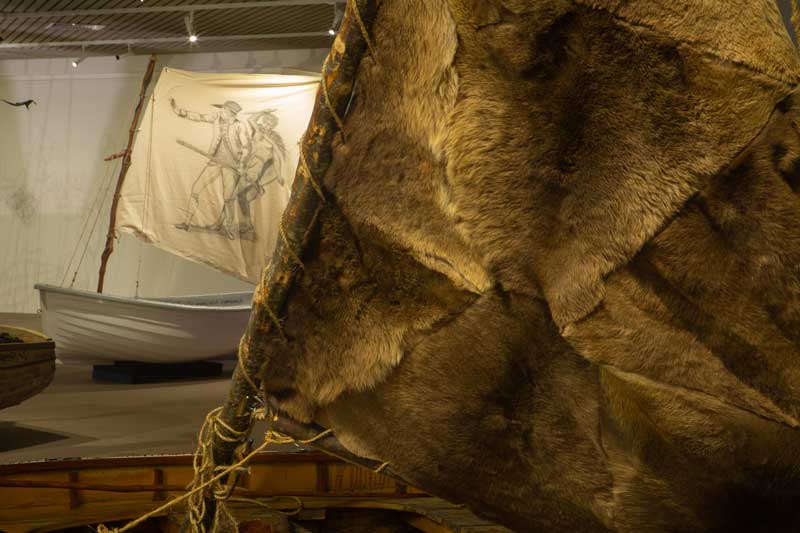
But angels say – on yesterday –
Just as the dawn was red,
One little boat – o’erspent with gales –
Retrimmed its masts – redecked its sails –
And shot – exultant on!
In Emily Dickenson’s poem, “Adrift! A little boat adrift!” many boats sank amid storms (“gurgled down and down”), but only one survived. The eight dinghies presented in this exhibition have also survived many years and many journeys, and in the hands of eight artists, “shot – exultant on”, are carriers of ideas and concepts, navigating and charting the sub-text of this exhibition: “Does place matter?” Curators Pat Hoffie and Rosemary Miller have devised an ambitious project which runs across two years and includes twenty new installations, twenty regional artists and communities and four regional locations.
A number of repurposed boats will move on to each new destination but the majority will arrive empty, to be re-filled with the work of local artists, just as ships arriving at a port unload and refill their holds with local goods. To quote from the Curator’s synopsis, “As the project grows, more and more partnerships will be established; the ‘specified goal’ we all share is to think a little more carefully about these places we live in, and the communities we are part of, and to consider the extent to which those of us who are lucky enough to live in regional areas might share values and experiences.”
Boats carry a heavy cargo of symbolism and metaphor. In their wake flows a rich mythology and trail of history. Journeys in boats are commonly conflated with the journey through life. In the tombs of Egyptian pharaohs even full-sized boats were placed so that the pharaoh could travel on even into the afterlife. Many ancient and archetypal associations accrue to boats. According to the Taschen The Book of Symbols, included in its metaphorical meanings, “The boat denotes those things, material, spiritual, energetic, that suddenly appear on our horizons and are brought to shore.”

For this, the first iteration of the exhibition, The Partnershipping Project consists of eight re-purposed dinghies. Each artist was allocated a dinghy, all well-used and close to, if not at the end of, their time at sea. The broad nature of the brief has led to a diverse range of interpretations. Some, like Lisa Garland’s My Brother, the Fisherman 2018,are personal and local in essence yet Garland’s craft still evokes a broader meaning since her brother is also a strong activist for the environment and sustainability, particularly in terms of marine resources. The boat is not rigged, it has a cover over the hull, onto which a large photographic image of the artist’s brother has been applied. Projecting from the cover is the skeleton of a large marine creature, suggesting that the days of catching such animals have passed into mythology, due no doubt to overfishing and the degradation of the local marine environment.
Greg Leong’s The Tasmanian Migration of Oriental Carp, similarly quite personal, arises from the experience of being a Gay Chinese man in Australian society. Leong uses the Carp (which is a pest species in Australia) to symbolise Australia’s rejection or deep suspicion of other races and minority groups. But ironically, to the Chinese the Carp (or Koi) is a symbol of Love. His Carp are represented as skeletons wrapped in joss paper (gold and silver for the dead), further referencing the tragedy of the so-called “Boat People”.
Selena de Carvalho’s well-worn clinker-built dinghy is filled with charcoal collected from a burnt rain forest in the Weld Valley. She addresses the environment in virtually all her work, specifically visiting “environmental sites of disturbance.” Her work is consistently based in her direct experience of these special places and the damage we do, also to ourselves, through our detrimental life choices. Her boat is filled to the gunwales with charcoal collected from burns in logging coups and its exterior is covered in the words of a poem by the artist entitled 100 Year Flood written in ink made from the collected particulate matter in car exhaust fumes. This piece also asserts a powerful sculptural presence, with the uprooted and erect figure of the mast symbolised by a chunk of drift wood, and its tattered sail reminiscent of the perils portrayed in Turner’s paintings of storms and shipwrecks. As the artist writes:
short attention spans rule // sign in sign out
passwords reset
locked gates
forestry make smoke signals no-one can interpret”
a sublime hazy sunset
horizon is a cigarette brand
face like a screen saver
the mountain is not ours to label
short attention spans rule // sign in sign out
passwords reset
locked gates
forestry make smoke signals no-one can interpret
a sublime hazy sunset
horizon is a cigarette brand

Issues of invasion and colonisation are both directly and obliquely addressed in Partnershipping. Greg Lehman’s A Short History of Cook consists of a clinker dinghy, a smaller version of the type Captain Cook would have used, rubbing its hull up onto the beach, with its sail set, as if having just carried Cook and his sailors to shore. On the sail is a drawing, a copy of an unfinished drawing by John Webber depicting the first encounter with Indigenous Tasmanian people. It shows Cook presenting a medal to the leader of the Neunone nation. In this first image of a Tasmanian Aboriginal person the apparently harmless gift presages a dark intent, since Cook had received secret instructions to take possession of any lands he encountered. The white interior of the hull is covered in the words of these instructions, interspersed with Cook’s comments on his encounters with the natives as well as a text from the Native people of Hawai’i where Cook was killed two years later, including the following: “After being knock’d down I saw no more of Capt. Cook, all my People I observed were totally vanquish’d.”

David Mangenner Gough, a Tasmanian Aboriginal man, also has a boat with sails set in his work Te Waka a trawlwoolway (the Canoe/Boat of trawlwoolway), but these sails are made of the hides of marsupial animals. In this work David collaborated with Nathan Slater who is of Maori descent and with whom he hunts, tans hides, fishes, dives and stays on country. The artists worked on the boat at a beach using found objects to construct its rig, just as his ancestors used whatever may have washed ashore. In his artist statement Gough states – “We see place and landscape in ways to utilise in our practices, respect, and protect into the future. We also see how the changing world and different resources can become available to use in our practices. These new materials may alter some process but the result is still achieving our cultural aims.” This process was documented and the resultant video is projected on the mainsail of the dinghy.
Joan Kelly spent the first five years of her life living in the rainforest, but her family regularly visited the coastal beaches of north-western Tasmania. From early childhood she was quite aware of the past presence of the Aboriginal people through the clear evidence of their inhabitation over thousands of years living along these shores. When the family moved to Table Cape they remained strongly aware of that continuing presence, as well as the sea virtually surrounding them. Her work First Impressions – The Coastline (2018) consists of etchings on scratchboard, mounted on upraised oars (perhaps hinting at arrival). This work inevitably draws on the perspective of the colonisers as invaders, but also suggests the kinder, more benign impulse of a more innocent and simpler past and way of life, that clings to these places with a sadness that can never be completely erased.
Although more well-known for his public mural work, Jamin’s gallery-based practice often employs new media and technologies. His work, The Gap Between Worlds (2018) consists of a dinghy in which the rigging has been replaced with horizontally arranged bands of flat mirrored mylar, somewhat reminiscent of sails, and accented by blue LED lights, doubled by a further layers of the same material in the hull, giving the impression of looking down into the sea. As a meditation on form, this work is enigmatic and sensorially engaging, with the LED lights adding to it a party element.
Ritchie Ares Dona’s practice is similarly defined by carrying cultural cargo from one place to another He states “Cultural Transmission is a transportation and integration of my childhood, culture, values and traditions to my new home in Tasmania.” Cultural Transmission (2018), references Place by focussing on the repetitive process of making that he encountered in his childhood in the Philippines. Making a hut from Bamboo and folding coconut leaves and planting rice were two of the processes which came to mind as he meticulously and painstakingly cut and folded 9,170 sheets of transparency film and polycarbonate in reference to hills on the island of Bohol and the regular rippling peaks and troughs of the water perhaps. This is one of the most visually arresting and elegant works in the exhibition.
.jpg)
Collectively, these humble little vessels sail on, a flotilla of dreams, memories and hope – hopes dashed, and hopes for a future to come. They are the trusty survivors, heading off to each destination, each new venue (many far from the ocean), worn and patinated by time and laden with cultural riches from distant places.
There is a boat down on the quay come home at last.
The paint’s chipped, the sails stained as if
Time’s pissed up against them.
I imagine the sea routes it's followed,
Sailing through the world’s sunken veins
With its cargo of longings;
From Brian Patten, “There is a Boat Down on the Quay”
